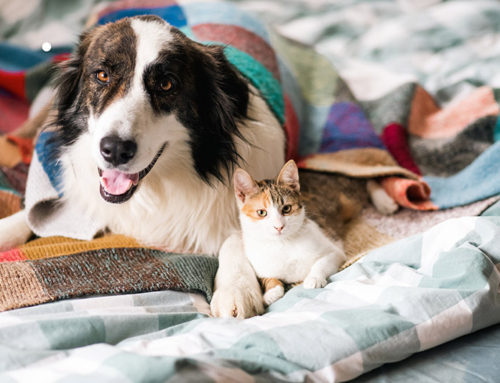FELINE FITNESS
Cats engage in two types of play. The first is social play, where they romp, wrestle, and chase one another, and the second is object play, where they stalk, pounce, chase, and play with an object. These are the most effective ways that you can get your cat up and moving. Be creative and try to think like a cat when creating toys for them. Keep in mind that boredom is the culprit. Instead of giving in to your frustrated feline who toe bites or vocally complains, try giving your cat attention, doing obedience work, teaching it a trick, chasing it around the house, playing with a feathered toy, or doing some other form of exercise to divert its attention from food and burn extra calories. With a little creativity, commitment, and determination, you can achieve a daily or twice-daily 15-minute flurry of activity for your cat.
• Get a kitten or a second cat that it can chase around.
• Buy interactive toys such as mechanical mice or moving toys.
• Purchase a cat video.
• Use a laser pointer.
• Bring home new toys that your cat can chase.
• Buy catnip or catnip toys.
• Play chase up and down the stairs or around the house.
• Wad up paper or foil to use as a ball.
• Buy rubber or ping-pong balls for your cat to chase.
• Use remote-controlled toys.
• Use a feather on a wand to entice play.
• Make a maze out of boxes.
• Train your cat for agility (see www.catagility.com).
• Place large containers or paper bags for cats to climb into.
• Purchase a large cat tree with several levels.
• Make an outdoor enclosure for your cat to play in.
• Increase your household activities to entice your pets to join in.
• Engage your cat in some form of exercise every day.
Scratching as exercise
Cats are unique in that their nails are sharper and more curved than any other mammal. They’re also carnivores, so in the wild their nails help them grip their prey. Now that your cat is domesticated, that prey sometimes becomes your furniture. Cats scratch for a variety of reasons. This includes marking their territory (both visually and with scent glands in their pads), stretching and strengthening their muscles, and sharpening their nails. But not to worry: With patience and training, cats can coexist very nicely with a pricey couch. Here’s how to train your cat to use a scratching post.
• Try different scratching posts to see which surfaces your cat likes.
• Make sure the post has a wide base and is stable enough for the cat to stand up and pull down on the post.
• Spray the post with catnip if your cat likes this smell.
• Attach dangling toys around the post to entice the cat.
• Play with your cat around the post.
• Praise your cat after it uses the post.
• Put scratching posts in locations where your cat likes to scratch. Many cats like to scratch when they first wake up, so if they sleep with you, put a post by your bed.
• Train your cat to stay away from your furniture by putting double-sided tape or aluminum foil on the furniture where they scratch.
• Spray your furniture with lemon cleaner. Cats usually dislike the smell of citrus.
• Kittens tend to use their nails more than adult cats, so start working with your kittens as soon as possible.
• Use loud noises or a squirt bottle with water to discourage your cat from scratching the furniture. Repetition is important.
• Trim your cat’s nails on a regular basis. Your vet can show you how.
• Try Soft Paws. These are plastic coverings for your cat’s nails that you can buy from your vet.
Most cats can be trained to use a scratching post instead of your furniture, so don’t give up! Remember, cats have a natural instinct to scratch. This is a very normal behavior, and with a little bit of guidance you can teach your cat to scratch their posts instead of your furniture.
BENEFITS OF EXERCISE
• Fewer behavioral problems because exercise stimulates your pet’s mind and body
• Your pet gains social skills through human interaction on a regular basis
• Strengthens the bond between you and your pet
• Strengthens the respiratory and circulatory systems
• Helps oxygenate cells and tissue
• Keeps muscles toned and joints flexible
• Releases energy and relieves boredom to keep the mind active
• Aids in digestion
• Burns calories





